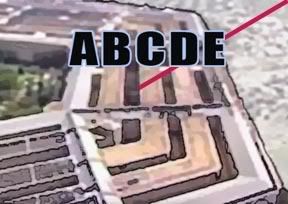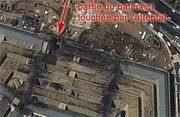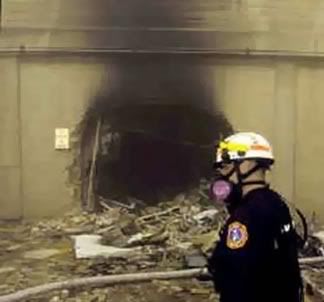To understand the dry humor with which I take the following arguments, it helps to understand the depth of Flight 77’s penetration of the Pentagon. The world'slargest office building consists of 5 sides with five corners and five concentric rings, labeled A-E; Each ring, when viewed from above, is separated by a space for light and air. The massive Flight 77 hit the outermost E ring, on the southwest-facing side at a 45 degree angle from the south and disappeared inside the building, according to the official account burying itself over 300 feet into the building through rings E, D, and C, terminating between the C and B rings, in a ground-level roadway known as the "A-E Drive." (just about dead center in the picture above)
One evident mistake on the original
Meyssan-produced Hunt The Boeing site that has reverberated through the works of others is the contention that since only the E ring showed signs of damage when viewed from above (see right - and 'damage' seems to mean total collapse), “it is clear that the aircraft only hit the first ring. The four interior rings remain intact. They were only fire-damaged after the initial explosion." The younger Meyssan asked his readers "how a Boeing 757-200, weighing nearly 100 tons and traveling at a minimum speed of 250 miles an hour only damaged the outside of the Pentagon?”
Likewise, Australian 9/11 Truther Gerard Holmgren looked at this building layout and decided less than two months after the attack “I have estimated the depth of the ring itself to be about 32 feet [note his use of the singular “ring”] and the open space behind it, about the same.” I estimated closer to 45-foot rings and 30-foot spaces, but he may be closer. Whatever. The point is, his contention that “the outer ring collapsed, leaving a total depth of about 65 ft that the plane could potentially have fitted into, considering that the second ring of the building was intact.” Indeed, many skeptics, especially early on, saw only one ring collapse and presumed only one ring was damaged. Raphael Meyssan said precisely that, and an intrepid few no-planers pained themselves to look on the ground between the rings and saw no debris or damage there. The ground there is clear, so the attack object never entered the other rings and never left the outer E ring.
Likewise, Zionist-JFK assassination obsessed Eric Hufschmid has made this same exact case (in at least one exception to the Franco-German War construct). This I found in his intensely researched and richly illustrated book
Painful Questions, released September 2002. The "Flight 77 Hits the Pentagon?" section of his book also carried headings like "the airplane was larger than one floor," "where is the airplane debris?" "Two pieces of the airplane were discovered," "where is the aircraft debris?" "the terrorists were the world's best pilots," "the CIA drones," and "if it looks and acts like a drone..." He also cites two explosions, one from "the missile," and the other from "a bomb inside the Pentagon." The illustration at right is a scan right from the book, where he too sees only one ring penetrated, clearly nowhere near enough space to fit the missing plane. He did show the punch-out hole inside the C-Ring, but mistakenly cited it as on the inside of the impacted, outer
E-Ring. Such a gaffe is noteworthy, in that any place for the plane to hide is "squeezed inside the red area of figure 9-10" and inside the red-flag area of worse-than-worthless 9/11 theories.
This is the punch-out hole Hufschmid cited on the inside of the E-ring. By 2004-05 most people had figured out it was actually on the inside wall of the C Ring, right on the A-E drive (hence the no parking sign next to it). But for the plane to get there, they still saw six walls’ worth of the stuff smashed through in the "E" and "C" rings. But this ignores another key fact – that it only had the two heavy walls to contend with (explained in my
“nine feet of steel reinforced idiocy” post). Meyssan, Hufschmid, and Holmgren at that time could not see that the spaces between the rings wasn’t ground but roof over the second floor, and the plane pierced the building at the first-floor level. There is no ground-level exit on the inside of the E-ring. The spot Hufschmid showed does not exist on this building.
But that was 2002 - I checked on the current status of Hufschmid's argument in
Painful Deceptions, his video first released in February 2005. He no longer shows his red area of the E-ring, but still says “the passengers and debris from Flight 77 were confined to a very tiny area” and implies neither was present at all, arguing forcibly for a Global Hawk drone strike. At 17:53 his narrator says "it is obvious that whatever hit the Pentagon was not big enough to be a Boeing 757." He showed a location shot described as “the corridor between rings. There is nothing in this rubble that looks like Flight 77 or pieces of luggage.” All that’s there is broken glass and intact (reinforced) windows that fell from their moorings. But that’s to be expected. It’s the back side of the E-ring’s third floor, which was badly shaken but never entered by the plane. What he seemed in 2005 to take as the ground level between rings is actually the roof of the second floor, well above the plane’s massive damage. He seems to think this photo is of a spot near his misplaced punch-out hole, which he then shows and points out again no plane wreckage, but no longer specifies just where it is in the building’s ring structure.
Despite the slight back-off on this embarrassing gaffe, Hufschmid still clearly qualifies as a Frustrating Fraudster of the first order. His case at the Pentagon at least is stupid and flat wrong, and I will cover it more in-depth in an upcoming post reviewing
Painful Deceptions' take on that evidence in total. If you'd like the review to seem more relevant, feel free to
watch the video yourself first. I haven't looked into Holmgren's current take, but from the way all these guys operate, once they've staked out an argument, it becomes their trademark and their turf, and they never abandon it no matter what. I'd bet money he hasn't modified anything significantly either.













2 comments:
Good post. The only thing I'd add is that the punch-out hole is quite obviously not through steel-reinforced concrete, but through a masonry (brick) wall which appears to be something less than one-foot thick.
cool, thanks Pat. I've been behind on such details that need updating
I'm also working on new leads SLC mighht be interested in following... the "new" NTSB cartoon...
Post a Comment